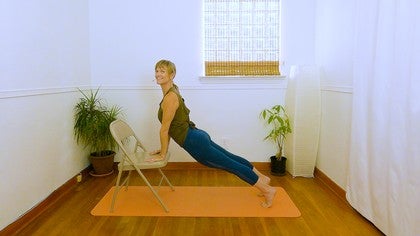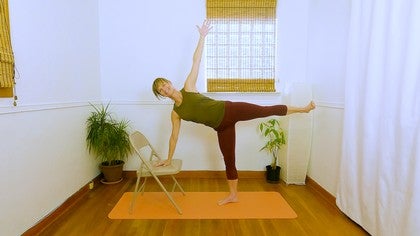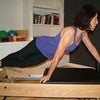Description
About This Video
Transcript
Read Full Transcript
Hi, I'm Allie Greene. And this is class six, final class of our Move Into Ease series. And in this class, we are gonna cultivate some curiosity and courage. Notice, I didn't say confidence. It's kind of like that saying that the journey is more important than the destination.
Curiosity and courage are the journey. Confidence is a destination. Chances are you're gonna arrive there and then only want to travel somewhere else. And your two best travel guides are curiosity and courage. Curiosity allows us to let go of the, what do I look like?
Am I doing it right? What if I make a mistake? And courage, those are those little moments when you're full of doubt, when you wanna quit, and you rally and you keep going. These two things interweave beautifully. So this class is all about finding joy, freedom, and self-agency through cultivating curiosity and courage.
So let's begin. I don't have a mat. Sometimes we limit ourselves because we step onto that rectangular piece of rubber and think this is as far as I should go. So I want you to get rid of your mat, roll it up, put it away, and really move into your space. Now we're going to start with a little weight shifting.
And our feet can begin to take a little walk so they don't have to stay, you know, right underneath of our hips. They can get a little wider. And I just want you to feel the shift of your weight, this fluidness of your body. Get curious, like what happens if I go over here or there? I'm not sure I can go that far.
Well, then we can have a little bit of courage and see. But guess what? If that was too far, come on back. Maybe you need a little bit more support. Saying that we need support is an act of courage.
All right, so from our shifting weight, let's move into a little bit bigger. What if we get some figure eights going and we really move in and out of the ground. We have our three weights, our pelvis, our ribcage, our head, and they're all balancing each other. This little side to side. Now, this is a pretty physical class.
So if you're finding that you'd like to take a break for a little bit, you know, you can always pause video, come back or get some water, and you can always make the movement small, make it your own. Now let's go ahead and turn this into some swinging. Nice little swinging. Let your arms be free. Who cares what it looks like?
Let it swing around. Maybe you even slap yourself. Maybe you even wanna turn your body, turn around, spiraling. See your space. Get curious, what's around me?
What's on the ceiling? What's on the floor? Little swing. Swinging like this is really great for our nervous system as well. So in order to find a little bit more balance with that doesn't always have to be like quiet, deep breathing.
We could swing like this. And then let's let it get smaller and smaller. So we can play with tempo. We could play with, what if we got slower quality of movement? So just finding some beautiful freedom, playfulness, joy in our movement.
Just how good it feels to move and not worry about what we look like if we're gonna make a mistake, and let's slow it down, moving into some stillness. Now we're gonna shake. So can you start that shake in your feet? And it's like, how jiggly-wiggly can you get? So this is another really great practice for your nervous system.
If you're really stressed or if you've had something happen to you that's kind of like a little upsetting and you feel like you're stuck in that fight flight, you can shake it out. You can let it go. Just let everything go. You can work this up your body. This is definitely like, who cares what people think?
Let's just self-shake. Nobody's around. This is just for you. Isn't this fun? (laughs) This was just silly. I mean, when's the last time you did something like this?
It's very freeing. Shake it all out. Shake it, shake it, shake it. You can make it as big as you want. And then just let it settle in.
Feel all of that aliveness in you now, all of that vibration. Now, we're gonna move in to move out. So we're gonna make ourselves into a very small shape, this folding inwards. You can get as low as it works for you. We pull all of our limbs in, There's that naval radiating pattern.
And then we're gonna open up. And I want you to take up space. Take up space. Here I am. Here I am. I'm not going anywhere.
And bring yourself back in. Fold into yourself. I'm giving myself support. You know, I just wanna go in so I can rest, so that I can move out. I'm gonna take up space.
I'm gonna reach and open. And let's go back in one more time. And maybe turn and face a different direction in your room. See something else, be in relationship in a different way. And then open back up, really big, really big.
Take up the space. You can look around, and then bring everything back in, and let's come back to each other. Super. Now, let's do a little squat and a tap. Just a little squat and a tap.
Gravity takes you down. Space takes you up. Your arms can do anything they want. So this is some, I'm gonna call this like adult creative movement class. Freestyle.
Ah, what do you feel like doing? Get curious. What does it happen if I wrap my arms when I do this? What does it happen when I lift my arms? Now, what if we went into a little bit more of a balance?
You can always keep your toe down, too. Maybe you're curious about, I just think that's interesting. And then what if from this balance, we crossed over and then we came up? Who cares what it looks like? Go back down into your squat.
How about another balance? How about we take it behind? Lift. And now we can move it out a little bit and just move through your space. You're falling and catching yourself.
You're curious, what happens if I go this way? What happens if I do this? We can go across and back, having fun with our beautiful moving bodies. And then let's bring ourselves back. Let's quiet it back down.
Let's just go into those nice easy figure eights so we can get curious about this. What does a small quieter movement feel like as opposed to those bigger, louder movements? Now, let's try those squats on the other side. We can start small. There's interesting things in small things.
There is strength and softness, and variety is the spice of life. Not my quote. So play around. What if you find a balance? But if you suspended and you hung out in space for a while, and then came over.
So we're moving together, which is a beautiful thing. Moving in community, moving with other bodies. It doesn't matter that we're not in the same room. We can still feel each other's energy and the joy of moving with someone. And we don't have to be doing exactly the same thing.
Let's do a few more of those. I think I'm gonna try one of those big balances again. See where that takes me. Oh! And then returning in. Just take a little rest.
Coming back to those small movements. We keep on moving. We're still on our journey. These are our little pit stops along the way. Ah! So from here, we're going to do something I just call eye lunges.
So we can start to make these movements a little bit bigger, side to side. Our eyes connect to the nervous system. So they can actually help us with coordination, integration into our body. And there's certain ways that we can practice that. So the first eye movement that we're gonna do is where you feel like you lost something.
I don't know, small like a screw dropped out of your hand or an earring fell out of your ear. And then you're looking for it on the ground. And it's so small that you've got to get your gaze down to the ground. And then you find it. And you go right down to it.
Your gaze has to narrow. Pick it up, take a look at it, and keep going. And then it happens again. And we can take that to the other side. Whatever you dropped, look for it.
See it. Go to it. Pick it up. Back and forth. Let's try that one more time each side. You dropped it. You look. There it is.
Focus. Bring it to you. And we go. And let's do it again. Where did it go? There it is.
Pick it up. Now what if we just did that every single side? We're very clumsy today. We keep dropping things. Look for it, see it, bring it to you.
Look for it, see it, bring it to you. Let's do two more. Look for it, see it, bring it to you. Look for it, see it, and bring it to you. Let's keep our lunging.
Let's keep traveling. Now our next eye focus is going to be out on the horizon. It's the super-wide gaze. Like you were standing on a beach and you were scanning the ocean, or you were standing in a field and you just see this huge meadow in front of you. So we're gonna take our arm across and look and look and look.
It's just never ending. Our eyes are so open. They're scanning the horizon, scanning the horizon. And see how smooth those eyes can be. Do your eyes jump to the middle?
Can they just keep that smooth open gaze? Get curious about what your eyes do. Let's do one more each side. Nice, smooth gaze. That's what we're going for.
And then return and let's keep going. Stay on our journey. Our last one, we're gonna see the universe. We're gonna find a little piece of that universe that looks really interesting to us. And we're gonna pluck it.
We're gonna take a look at it. But we're gonna put it back where we found it. So we don't wanna disturb the universe. So here we go. Can you look up and see the whole universe?
And then, ooh, that looks interesting. Pluck it. And I want you to pull it to your eyes. So close you almost go cross side. And then I want you to put it back. Follow it.
You gotta put it right back where you found it. (blows) And we keep going. And let's try that on the other side. Over you go, see the universe. Little piece you wanna look at.
Go ahead and pluck it. Bring it right to your eyes. Close in as long as that feels okay. If it makes you dizzy, little less. Put it right back where you found it.
And we keep going. Let's do that again. Over to the other side. See the universe. It's like everywhere.
What piece do I wanna? That right there. Bring it to me. Take a really close look. Follow it. Put it right back where you found it.
One more to the other side. See the universe. Find one little part that you wanna get a closer look at. Bring it to you, put it back. Follow it, let it go.
And we keep doing our lovely lunges. Now, we've been in one space for a while. I want you to take a walk around your room. Now I'm gonna stay right here 'cause I wanna stay in view of you. But I want you to take up space, walk around your furniture, walk in and out of the room if you can still hear me.
See everything you possibly can. Look at the floor, look at the ceiling, look at your surroundings. You're taking your energy through your space. Dancers would call this warming up the space because we're full of energy. So we're moving that around.
Maybe we're sharing it with someone else's. Walking, feeling ourselves, move through space. Oh, hello, plant. Oh, hello, wall. And just keep on walking.
And how about, I'm gonna give us all a countdown, and we'll meet back together when I get to one. Eight, seven, six, five, four, three, two, and one. How was your trip? (laughs) What did you see? Did you get to experience your space maybe in a different way than usual because you were curious? Beautiful.
So our next little practice, I call them Shiva lunges. So Shiva is an Indian God. And he's always posed in these positions. So we're gonna find that balance. And you can take a little lunge over.
And what we're gonna just start with is a tap to cross. Okay? We're gonna build up our courage. Little tap to cross. So crossing midline makes our brain have to cross over and talk to itself.
Little crossing midline there. You can also see what it feels like to have a seat. Let gravity take you down, let space support you. Who cares if you fall down? I don't care.
I'm proud of you for trying. And then let it go. And a little lunge, try another one foot on the floor, crossing over, whatever floats your boat, and up. Now, we can, this time, take our arms up. What if we crossed our arms over as well, and then had a seat, and then cross them back over and down you go.
And a little cross and have a seat. So what we've gotta do, we have to release. Don't worry about being in a certain shape. Don't worry about falling out of this. And we can pick up the pace.
You could make this as big as you wanted it or as small as you wanted it. It's a little courage to find that suspend, and then have a seat. Let's do one more of these, little Shiva seat and back out and come on in. Okay, before we go to the other side, let's just take a pit stop and do a couple roll downs. So just nod your head, following down.
Now we got to experience our body in all these different systems. What do you want to use for your roll down? Is it your heart, your lungs? Do you wanna follow your center? Do you wanna notice your support?
Gravity and space? And a nice little push, coming up. This gives us a chance to catch our breath. And I'll roll. And we can get curious about slowing down.
We can get curious about being quiet. And sometimes it takes courage to be with ourselves, right? All those thoughts in our head, all those feelings. And then let's go to the other side. So we can just start our little lunge, and then a little crossover.
Little lunge and cross. And then your choice. You can keep the foot on the ground. You could find a little seat and come out of that. And you could also switch back and forth.
What does that feel like? Beautiful. All right. Now what if we went out and we took those arms out? And then we're gonna push.
And when we come up, cross everything over, have a seat, cross the arms and lunge, and a little push, find the suspension. That was fun. (laughs) And then back out. And we go up and we go out. And if your arms change, who cares? Doesn't matter.
We are having just this wonderful journey with ourselves. Hello. Let's do a couple more. I'm definitely noticing this side needs a little bit more support. How about that?
We just don't need to be perfect all the time. It's not interesting, in my opinion. And then bring yourself up. Let's roll down. Feel your feet on the ground.
Let them move. Rolling down. What is it that you want to get curious about when you roll down? Are there places in your body that don't like to roll? Are there parts of your roll that go faster than others?
Why is that? Or slower? Soften into the support of the ground. What about your head? Can you move it around and then push through the feet??
Roll yourself up and take a little pause, just to be with yourself. Now we're going to do a sounding exercise. So one of my teachers said, "You don't need to find your voice. You need to learn how to use it." And a lot of us are really good at moving around, but then when we have to open our mouths, ooh. So we're gonna practice using our voices.
So the first sound that we're gonna make is an ah. Notice when you do that, your mouth goes up and down round. There is vibration with sound. This vibration moves through this plane in your body. So we're gonna add some movement to it as well.
This doesn't need to be really loud. You don't wanna feel like anything is forced. You wanna have that support. So we're going to do an ah four times. Here we go.
Ahhh. And we're moving in that plane. Ahhh. Curious about how our body feels. Ahhh.
Curious how that moves up and down. Ahhh. Take a pause. Beautiful. Takes courage to make sound to use our voice.
Now we're going to do an E. That goes this way and the vibration is going this way. So our movement is going to be in this direction, this plane. So here we go. We'll do four Es.
Ehhh. Ehhh. Ehhh. Ehhh. These sounds in these directions create a lot of vibration for our tissues.
So this is really waking the body up. Last one is ooh. And it goes this way. So our movement's gonna go this way. This will be fun.
We can ooh towards and away from each other. So ready? Here we go. Ooh. Ooh. Ooh.
Ooh. Take a pause. Feel yourself inside after all of that sounding. Notice the space around you after your sounding. We're gonna go on a walk.
If you are in Australia, I think you guys call it a walkabout. It's an adventure. You go out and see the world, but you know that you can come home. We're going to add another eye practice with this. And we're going to be practicing our peripheral vision.
So peripheral vision is when you're looking straight ahead and then you're able to see out the sides. This has two values to it. One, safety. We wanna be able to look where we're going, but we also want to be able to see if anything is coming our way that we might collide with. Two, stress and anxiety create changes in our blood pressure which tend to narrow the blood vessels of the eyes and we can end up getting a little tunnel vision.
So by practicing peripheral vision, we actually open those back up and we help the blood flow. So once again, I'm gonna stay in this area, but I want you to feel free to move anywhere you want. So let's go for a walk. And you are focusing straight ahead like you're walking down the street. But how much can you see out of the sides of your eyes without changing your head and without your eyes going that direction.
You can walk forwards, backwards, sidewards, in a circle, any way you want trying to keep that peripheral vision. Now I'm gonna get fancy. You know, I had to, it's the last class. I gotta get fancy one more time. Let's slow the walk down.
This is like our vacation walk. Notice what happens with that peripheral vision. Is it easy to see what's on the other, you know, sides, when we slow it down. Now, let's take it up a notch. And I'll call this the Midwest walk.
This would be you're walking down the street and you're past someone and it's enough time to say, "Hi, how are you doing?" And you could answer back, "I'm good. How are you?" So it's friendly. So it's just a little bit faster. What happens to that peripheral vision? Does it get a little bit more challenging to keep that field as open as it was when you were on your vacation walk? Now, we're gonna kick it up again.
I call this New York City sidewalk. Get going. You don't have time. You maybe have a time for a hi, or maybe you're not even making eye contact. That's kind of stereotyping New Yorkers.
I actually think that New Yorkers are like they wanna get done what they wanna get done. There's a lot of people in that city. But I've always found them to be quite friendly and helpful. But we are moving fast. Now what happens to that peripheral vision?
Is it harder to maintain? So you can practice this different tempos. Let's slow it back down Midwest. What happens? What happens to that visual field?
Does it get a little bit wider, easier? And let's slow it down one more time. Get on that vacation walk. You're on the beach collecting shells. And what happens to that peripheral vision?
And then let's bring ourselves home. Let's meet each other at home. Beautiful. Curiosity and courage. Confidence is overrated.
So thank you so much for joining me for this series. Thank you for your beautiful open mind and your beautiful open hearts. I hope that you discovered some new things about yourself. I hope that you deepened your relationship to yourself and that you will return to these practices time and time again. We are always in process as human beings.
So the cool thing is when you come back to this, you won't even be the same person. So you might find different things, new things, and you just keep going deeper and deeper into yourself so that you come home to yourself, you become that home, that place of support, that place where you can center yourself, that place where you can catch your breath, you can be with your heart, you can find your balance, and you can keep cultivating curiosity and courage as you walk about life. Thanks so much for joining me.
Mindful Movement: Move into Ease
Comments
You need to be a subscriber to post a comment.
Please Log In or Create an Account to start your free trial.
















